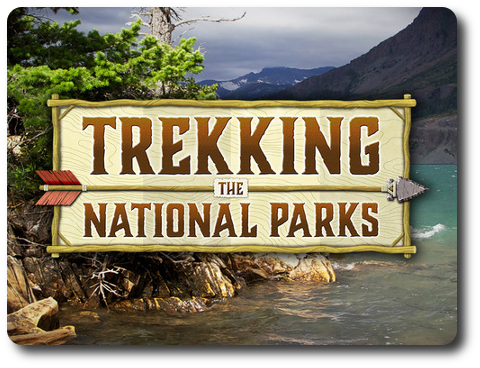
The Basics:
- For ages 8 and up (publisher suggests 13+)
- For 2 to 6 players
- Approximately 60 minutes to complete
Geek Skills:
- Counting & Math
- Logical & Critical Decision Making
- Pattern/Color Matching
- Risk vs. Reward
- Hand/Resource Management
Learning Curve:
- Child – Easy
- Adult – Easy
Theme & Narrative:
- See this great country of ours by foot
Endorsements:
- Gamer Geek rejected!
- Parent Geek mixed!
- Child Geek mixed!
Overview
The national parks of the United States are true treasures. Land set aside and then opened to all to enjoy, the boundaries of the parks contain natural wonders. Each year families jump in their cars and trek to visit these parks. Pictures are taken; memories are made. In this game, you will visit the different parks, as well. Each provides its own reward and treasure to be found.
Trekking the National Parks, designed by Charlie Bink and published by Bink Ink LLC, is comprised of 1 large game board, 6 player markers (meeples with hiking backpacks), 42 Park cards, 42 Stones, 1 bag, 8 Bonus cards, 90 Trek cards, 6 Reference cards, 18 Advanced Play cards, and 1 Park Guide book. The component quality is outstanding. The game board is thick, durable, and colorful. The cards are the same. I was most impressed.
Preparing for Your Adventure
To set up the game, first place the game board in the middle of the playing area.
Second, have each player select a Player marker color of their choice and place it in the “Start” space on the game board. Any Player markers not selected are returned to the game box.
Third, shuffle the Park cards and then deal a set number face-down to create the Park draw deck. The number dealt is based on the number of players. Place any Park cards not dealt to the Park draw deck back in the game box. Keeping the Park draw deck face-down, place it next to the game board and draw 1 card per play, plus 1 more, placing the cards in a row face-up. For example, in a 3 players game, you would draw 4 Park cards from the Park draw deck. This row is referred to as the “Active Parks”. The order in which the cards are placed in the Active Parks row is not important. If players like, they can organize the row by number value, name, or by whatever means makes sense.
Fourth, place all the Stones in the bag and mix them around. Then draw 1 stone per park location on the game board. A special symbol is provided to help players recognize where a Stone should be placed. Place the bag to one side of the game playing area once completed.
Fifth, place the Bonus cards next to the game board and face-up where all players can see them. Remove the “Most Total Stones” Bonus card at this time. This card is used as part of a game variant.
Sixth, shuffle the Trek cards and deal 5, face-down, to each player. This is the player’s starting hand. Deal 5 more Trek cards face-up next to the game board, placing them in a row. This is referred to as the “Draft Row”. Place the remaining Trek cards face-down next to the Draft row.
That’s it for game set up. Time to go on a hike.
From Sea to Shining Sea by Foot
Trekking the National Parks is played in turns with no set number of turns per game. A player’s turn consists of 2 actions out of a possible 3. A player can take the same action twice or mix and match as they believe necessary. A player’s actions are summarized here.
Action Option: Draw Trek Card
The player can either take any visible Trek card from the Draft row, adding it to their hand, or draw the top-most card from the Trek deck, also adding it to their hand. If a card is taken from the Draft row, the open space is not filled at this time. If a card is to be taken from the Trek draw deck and no more cards remain, shuffle the discard pile to create a new Trek draw deck. Trek cards come in different number values and types.
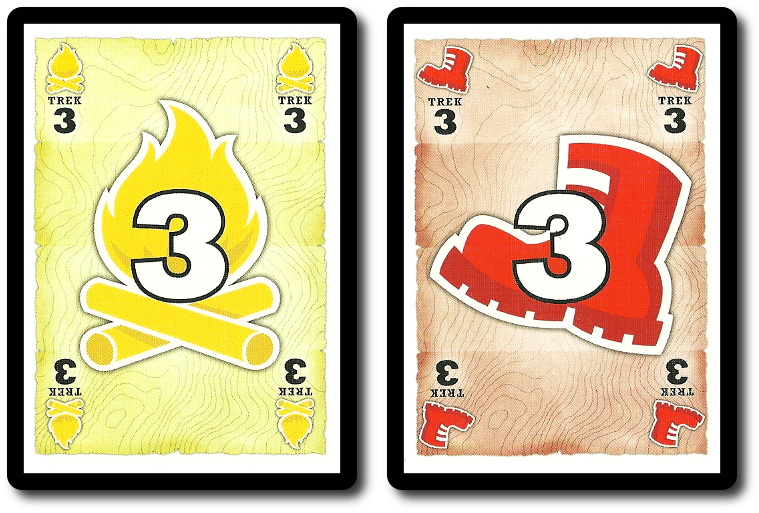
Action Option: Move
The distance between 2 points on the game board map, referred to as the “Trek value”, is indicated by a circle with a number. This is the number value that must be matched exactly by the player’s Trek cards. For example, if the distance between Point A and Point B is “3”, the player would have to discard a total number of Trek cards that have a number value no more and no less than “3”. If they can, the player’s Player marker is moved to the new position.
A player can move as far as they want on their turn, but doing so means they must add up the distance to be traveled by adding the number values on the path. Like a single move from one location to another, the player must be able to play any number of Trek cards that have a total value of no less and no more than the distance value. If they can, they move their Player marker to the new spot.
Airport locations allow the player to “jump” (or better put, “fly”) from one airport location to another. This does not cost the player any additional Trek cards, but there are restrictions. Once the player takes a flight and relocates their Player marker, their action is over. If the player has another action, they can then move on. If the player starts an action located on an airport, they can use it right away, too.
Stones can only be collected if they are located at the player’s final destination. This means a player will have to pass and go by other Stones if they are moving to a location that is further down the road. Stones acquired are placed in front of the player in their score pile. A total of 2 Stones are possible to collect per turn (2 Move actions).
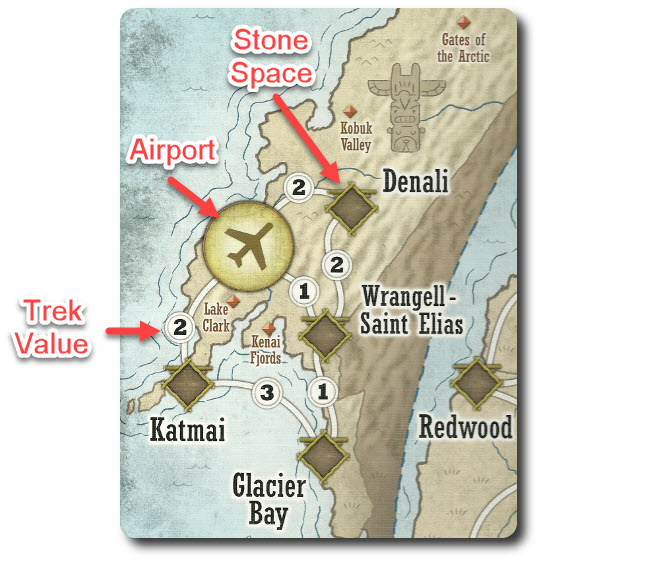
When traveling, the path taken must be continuous and cannot double back or cross back on the same path currently being taken. In addition, players cannot pass through or end their movement on a point where an opponent currently has their Player marker. This essentially allows a player to block another. The only location that can hold as many Player markers as there are players and be moved through freely are the airports.
All Trek cards used are sent to the discard pile.
Action Option: Claim a Park Card
The Active Park row shows and determines which parks are the only ones currently available for the players to collect and score. If the active player’s Player marker is on the park’s location, they may play the specific number and type of Trek cards indicated on the Park card. If the player can, they reveal their Trek cards, discard them, and then take the Park card, placing it in front of them, face-down. A new Active Park card is immediately revealed and placed in the vacant spot.
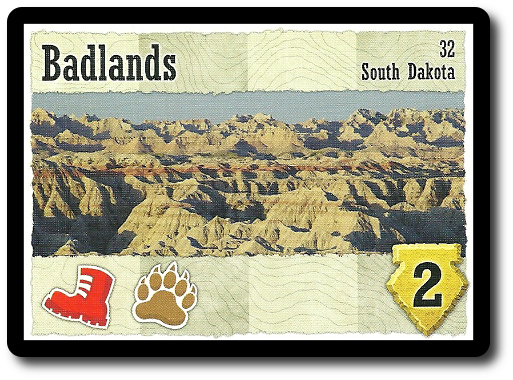
End of Turn
At the end of the player’s turn, they refill the Draft row, bringing the total number of visible cards back to 5. If necessary, shuffle the discard pile to create a new Trek draw deck and then refill the Draft row. The next player in turn order sequence now takes their turn.
Ending the Journey
The endgame is triggered one of two different ways:
- All Stones Collected: As soon as the last Stone on the game board has been claimed, the final round of game play is triggered.
- Last Park Card Drawn: As soon as the last Park card is drawn and added to the Active Park row, the final round of game play is triggered.
One last round of game play is now completed. The player who triggered the endgame will take the last turn of the game.
Final Scoring
First, award the Bonus card. These are given to the players who have met the requirements of each Bonus card. In the event of a tie, the Bonus card is not given.
Second, players count the points earned from their collected Park cards, adding that total value to any additional points earned from collected Bonus cards.
The player with the highest score wins the game. Ties are broken by counting the number of collected stones, with victory going to the player who has the most.
Game Variants
There are a number of game variants available for those who like to add a bit more challenge to their hike.
Park Post Cards
Park Post cards can provide the player additional points, but they will cost the player points at the end of the game if they are not used.
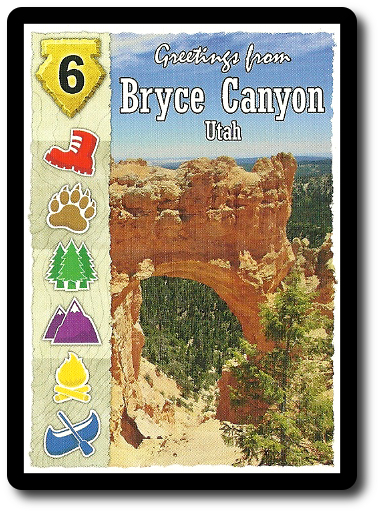
Advanced Play
Advanced game play is really just a slimmed down version of the game, with fewer Park cards and Park Post cards in play, making it difficult to acquire what one needs. In addition, the “Most Total Stones” Bonus card is also used. The game requires smarter hand management and better logistics, but is not anymore difficult to learn or to play.
To learn more about Trekking the National Parks, visit the game’s website.
Final Word
The Child Geeks liked the game, but always seemed to lose steam about 30 minutes into the game. When I asked one Child Geek his thoughts, he said “The game is OK, but it gets boring after a while. I don’t know what half of these places are, so all I am doing is just running there to get a stone.” When we introduced Parent Geeks, the games took on a new life and the missing energy the Child Geeks felt was suddenly returned. When I asked the same Child Geek what he thought of the game now, he said “This game is great with more people and a lot of fun playing with the family.” It would seem that, for the Child Geeks at any rate, the game requires the family in order for it to be a hit. When we took our votes, the results were mixed. Those Child Geeks who only played within their peer group found the game to be okay, while those who played with Parent Geeks found the game to be a great deal of fun.

One Child Geek reviews their cards, while the other determines the best road to take
The Parent Geeks’ story matched the Child Geeks’ story. Within their own peer group, the Parent Geeks enjoyed Trekking the National Parks, but never felt fully engaged with it. According to one Parent Geek, “Feels a lot like Ticket to Ride, but is missing something that makes me feel uninterested.” The Parent Geek couldn’t put his finger on what the game needed until we mixed the Parent Geeks with the Child Geeks. The game play was rejuvenated, as was the Parent Geeks’ overall interest in the game. Stories were shared, parks were discussed, and everyone in the game seem to be enjoying it on a new level. As one Parent Geek put it, “This, I think, is how the game was meant to be played. With your family.” When the games were over, Trekking the National Parks again received a mixed vote.
The Gamer Geeks didn’t care for the game. They found its production value to be outstanding, but quickly learned that the game was all looks and little else. According to one Gamer Geek, “The game plays smoothly and looks great, but failed to grab me. I was bored, to be honest.” Another Gamer Geek said, “A total snoozer of a game. Nothing about it captured my imagination, made me think overly hard, or kept me engaged.” While the Gamer Geeks didn’t think Trekking the National Parks was a game worthy of their elitist gaming table, they did suggest that the game was a good example of a “family gateway game”. As one Gamer Geek explained it, “This is the kind of game you play with the family when you want to get them excited about playing other and more interesting board games for the family. This would be a great first step.” When the trek was over, the Gamer Geeks were happy to see Trekking the National Parks take a hike.
The ideal audience for this game is the family. Parent Geeks and Gamer Geeks never felt that interested in the game when playing with their peers and the Child Geeks got bored. The game really came into its own when both Parent and Child Geeks played the game together, interacted with each other at the gaming table, and shared past experiences at various parks. This is what the designers had in mind, perhaps. A game that is not only played, but sparks conversations of past adventures and sights seen. Such a spark did not exist when the various groups played within their own circles. It was only when mixing the groups did we see Trekking the National Parks take on a life of its own.
The game is well designed and easy enough to follow. It also lacks much in the way of surprises or terribly deep thought. The actions are always the same and there is always enough information to make the best choice possible. The only difficult part is determining if you should draw a card blindly or not. Everything else comes easy. Not victory, mind you. That is something you’ll have to work for, but not in a way that requires a great deal of tactical or strategical thought. Logical thinking and logistics are the primary areas of focus in this game.
A bit of a side bonus to the game is the park guide that comes with it. Detailed in the guide are each of the locations the player might visit during the game. This adds a fun and necessary component to the game that educates the player as they move across the game board. Furthermore, it also offers an opportunity for players to discuss the different parks in the game, the part of the country they are located in, and the various reasons why the park exists in the first place. The guide does nothing to assist in game play, but does serve as a handy travel companion as the players make their way from one destination to another.
As a family man and Parent Geek, I’m most pleased with Trekking the National Parks. It plays close enough to Ticket to Ride to be familiar to everyone, but has a distinct feel and game play of its own. “Similar but different” is what I was often told by those attempting to describe the game. I concur. There is enough resemblance to quickly make comparisons, but the similarities do not go so far as to suggest similar game play. Do give it a try with your family when time permits.
This game was given to Father Geek as a review copy. Father Geek was not paid, bribed, wined, dined, or threatened in vain hopes of influencing this review. Such is the statuesque and legendary integrity of Father Geek.



